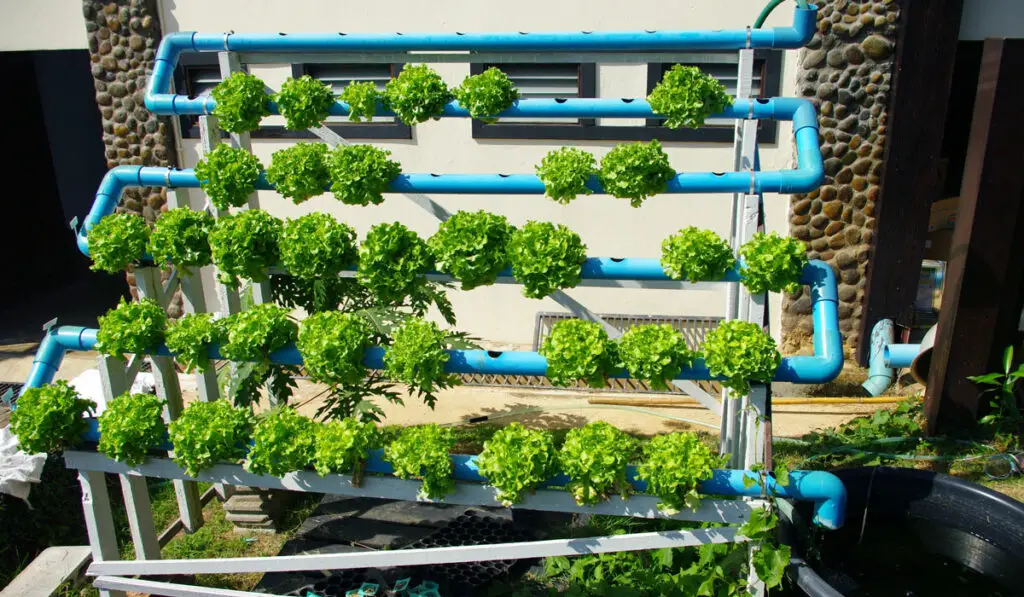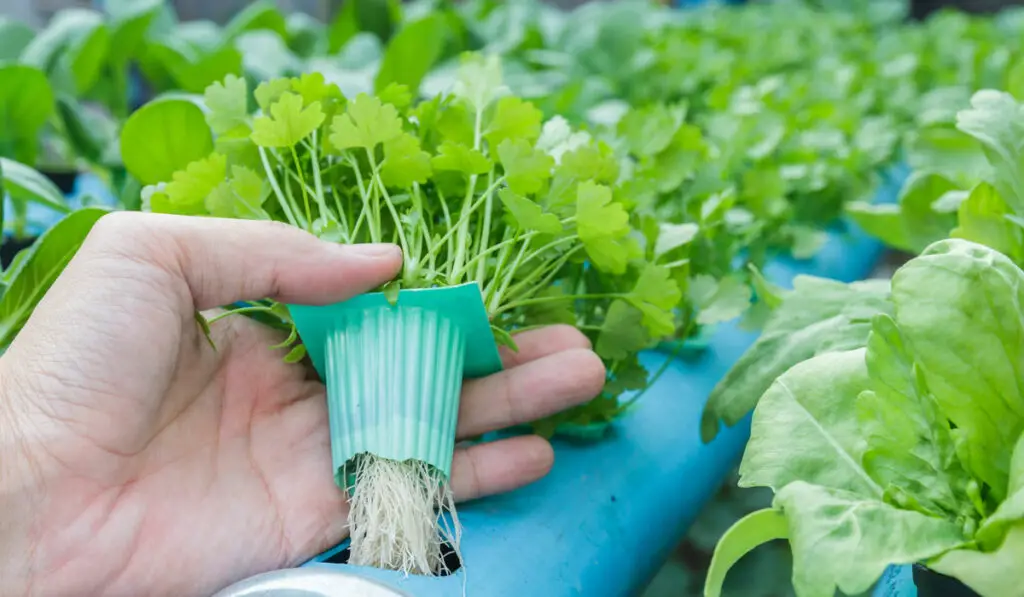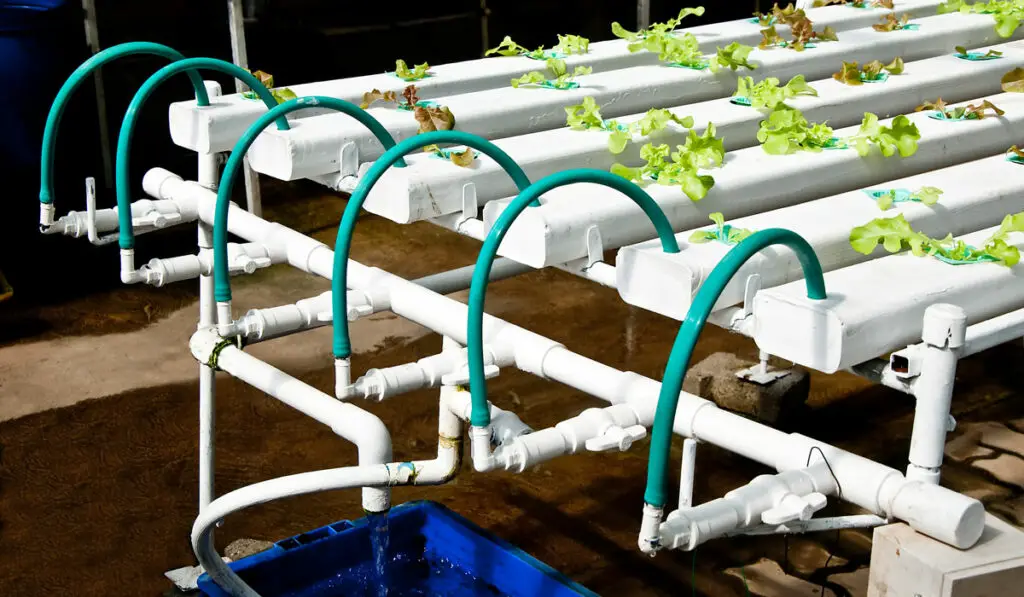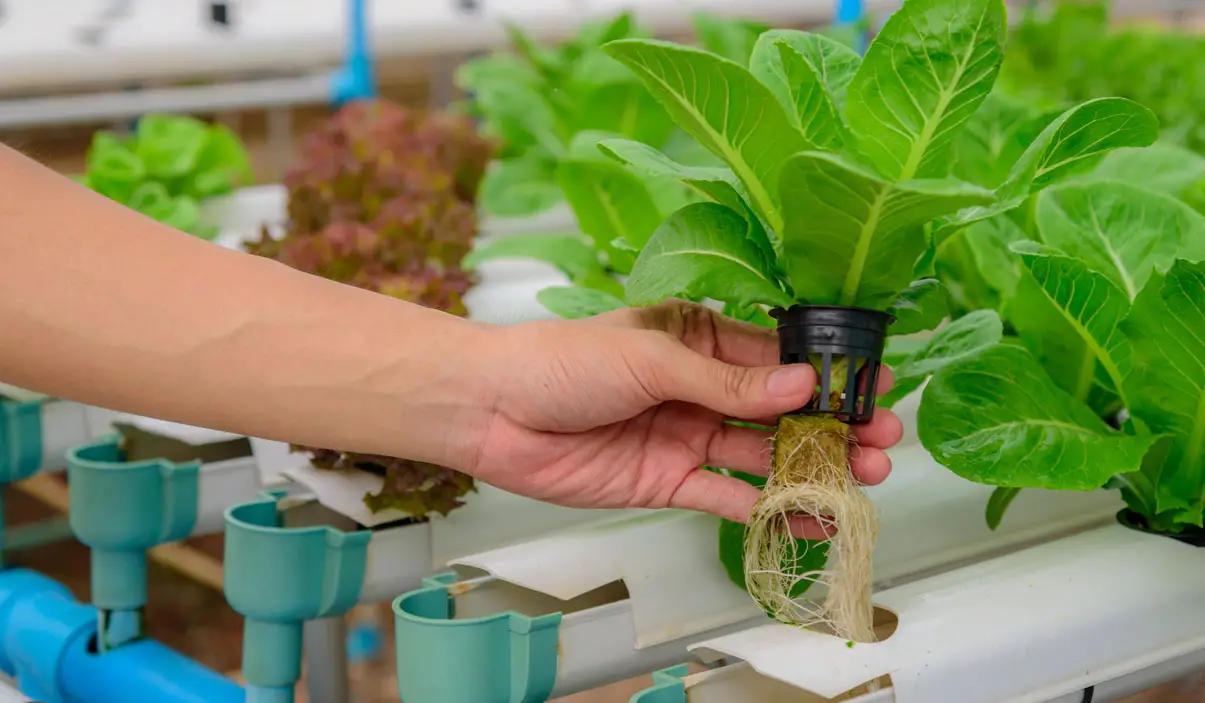How to Set Up a Nutrient Film Technique (NFT) Hydroponic System?

This post follows our research editorial guidelines.

Trust me, setting up a Nutrient Film Technique hydroponic system is incredibly easy. All you have to do is run to your local hardware store and pick up some PVC pipes, wood and a few other basic hydroponic supplies and you’ll be “High-Tec” growing in no time. Make no mistake, NFT hydroponics requires a bit more planning than a simple Deep Water Culture system.
All of what I’m about to describe can be set up in an afternoon with a strong cup of coffee (or tea). If you’re like me you also hate reading lengthy instructions so I’ve included the Coles notes version to skim through first, but if you’re wondering what the heck size should this drainage hole be! Then make sure you read through all of the sections before the power tools come out. NFT Hydroponic systems are great for growing shallow root system veggies like lettuce or leafy herbs like basil.

Table of Contents
The Quick Way to Setup a NFT hydroponic system.
To build out the structure, you’ll want to drill holes in your grow channels (aka your PVC pipes) and slope them so that water can easily flow through them. Next, set up your nutrient reservoir and then connect it to your pump. If you want, you can add a timer to this pump so you don’t have to manually control it.
Once your pump is connected to the reservoir, add an air pump and air stone to aerate the water. This will combat unwanted plant diseases such as root rot, which is traditionally caused by overwatering. Add your hydronic plants – such as fresh herbs – and start growing!
Of course, you can also buy a pre-made nutrient film technique system online, but trust me, they can be pretty costly. I really enjoyed building mine because it allowed me to customize the size I wanted for my apartment.
What Is the Nutrient Film Technique (NFT) Hydroponic System and How Does It Work?
A Nutrient Film Technique (NFT) is a system that consistently passes nutrients through to the root of a plant, which is dipped into a very shallow stream of water.
“Plants grown in hydroponics do not have soil as the source of nutrients, but the irrigation water is enriched with targeted nutrient elements to maximize plant productivity.”
Stacy Adams, an Associate Professor of Practice in Agronomy and Horticulture at the University of Nebraska–Lincoln
Not only does the NFT process allow the nutrients to get re-circulated repeatedly, but the roots of the plant get plenty of air surrounding them, which helps with successful plant growth and keeps the plant from being overwatered. Otherwise, it could suffer from root rot, which could otherwise kill it.
Nutrient Film Technique (NFT) Benefits:

A nutrient film technique is a great way to help your plants grow. As such, there are a number of excellent benefits to growing your plants this way, all of which are talked about in-depth below.
Here are 5 great benefits to growing your plants using the nutrient film technique:
Low Cost and Flexibility
First and foremost, this is a system that isn’t going to cost you a lot of money in the long run, which is definitely a great benefit of using it!
Some of the upfront costs of getting everything properly set up and getting the right equipment might end up being a bit more pricey than putting a plant in a pot, but in the long run, there’s very little maintenance that’s required with an NFT.
Since it’s constantly providing your plant with water and nutrients, all you need to do is set it up in an environment where it can thrive and make sure that the water pump stays working correctly. Outside of this, you’ll barely ever have to even touch your plants.
Low Water and Nutrient Consumption
Not only does your plant have its roots dipped in a shallow stream of water, but that water is constantly pumped in and out of the system with a constant flow of nutrients.
Since you’re essentially recycling water and nutrients regularly with this setup, you’re not wasting water. You don’t even have to worry about if your plants are overwatered or underwatered or if it’s getting enough nutrients. It takes the guesswork out of hydroponic plant growing.
Makes it Easy to Monitor Plant Health

Another amazing benefit to this kind of setup is that since the roots are open and not buried in dirt, it makes it easy to keep an eye on and diagnose your plant’s health. Especially if your worried about overgrown algae.
If your plant seems like it’s not doing great, no more need to guess if it’s due to root rot or some other ailment. You can simply check the roots, see if there’s any issue, and rule it out if there isn’t one.
With it being easier to rule out possible issues, diagnosing your plant’s health is a lot more straightforward, which can save you both time and money.
No More Salt Buildup
An issue that plants can run into is salt buildup at the root. This can cause issues and prevent your plant from being healthy. The added benefit of a setup like this is that with the water constantly running, you no longer have to worry about a salt buildup, which can make it hard for the plant to absorb nutrients.
Setup is Easy to Do and Expand Upon
So maybe you’ve decided to test out this system on a handful of plants you own. You’ve very happy with the results and you’d like to apply it to as many plants as you possibly can. What’s so great about this system is that it’s very modular and easy to expand upon if needed.
You can very easily add more plants to the setup and let them reap the same benefits. As long as you have the space and the means to add to your setup, you could water and provide nutrients to every plant you wish to grow like this.
How to Set Up a Nutrient Film Technique (NFT) Hydroponic System

Now that you know the benefits of using this kind of hydroponic system, let’s talk about how to set one up for your own use at home. Before we get started on the steps, let’s take a look at the equipment you’ll need to get started:
- Nutrient reservoir: The water needs to come from somewhere. This reservoir will hold the water and nutrients that will be dispersed to your plants.
- Pump: This will be connected to the reservoir and help circulate water through the system.
- Grow Channels: These are sloped areas that your plants will hang above and dip the roots into. The nutrient solution will flow through these to provide your plants with what they need.
- Timer: You need a programmable timer so you automate when water flows and when it doesn’t. This not only makes things easier for you so you don’t have to worry about doing things manually, but it also makes it easier to set up intervals to prevent overwatering your plants.
- Air pump and air stone: These provide air to the roots that help them grow even healthier.
Now that we have the necessities out of the way, let’s look at the steps it takes to set up a nutrient film technique hydroponic system.
#1 Choose Your Location
Finding the right location to set up your NFT is crucial. You need to make sure that wherever you are set up is nice and level. You also want to make sure that whatever area you choose has the proper sunlight and temperature requirements unless you decide to add in some grow lights.
Setting this up in a dark, dank basement probably isn’t best, but setting up in a place like a sunny room or a greenhouse might be better, depending on the requirements of your plants.
We recommend that you go with some sort of climate-controlled area with adequate sunlight. Having something mechanical like this sit outside might not fare well under certain weather conditions.
#2 Setup Your Grow Channels
You can either build these or purchase them. Either way, it’s important that these are set up properly. As I previously mentioned, setting them up on a slope is the best way to go. This allows the water to flow through without any issues.
Not setting up the channels on a slope leads to water not flowing properly and building up in a way that overwaters your plants.
#3 Install Your Reservoir and Pump
The next step is to add your reservoir and connect it to your pump. This will provide water to your plants and through the grow channels that you set up.
It’s important to check and see that the circulation of water is flowing properly. This is also a great point to check to make sure that your grow channels are properly sloped and that water can easily get from one point to the next.
#4 Add Air Pump and Air Stone
The last step to this process, before you start adding your plants, is to install your air pump and air stone. These both help with air circulation in your hydroponic system and provide your plants with the oxygen they need to grow big and tall.
#5 Add your propagated clones or start your seeds
I personally like starting from seed with every new grow. There is something exciting about the process that’s part luck (in my eyes) and part genetics. You don’t really know what you’re going to get until it’s there.
Since seeds love humidity it’s best to place them in water first to soak or directly in the growing medium under some grow domes to get things started. If you’re in a cooler area like me you may want to add some heat to the grow room or even start them on a war radiator like I do.
Once these are installed, you can begin the process of adding your plants. Your nutrient film technique hydroponic system is now in full effect.
Nutrient Film Technique (NFT) Drawbacks

There are a lot of incredible advantages to using this kind of system. However, it does have its fair share of drawbacks you need to consider before moving forward.
The first drawback is the possibility of the pump failing on you. This is a system that is set up to be pretty automated. You might not check in on your system constantly. The problem with that is that by the time the pump fails on you, you run a serious risk of killing all of your plants within hours of it happening.
You have to be aware of the pump failing almost as soon as it happens, and you need to react quickly in order to save all of your plants.
The other drawback is that this is not a system built for certain kinds of plants. If you have a plant with a large tap-root system or one that requires a lot of maintenance, this is not the setup for you.
While the idea of constantly flowing water and nutrients works great for a lot of plant types, it’s not the same across the board and a setup like this can actually do more damage to certain kinds of plants.
Done for You Nutrient Film Technique Hydroponics Kits
VEVOR Hydroponics Growing System
This is a great, affordable setup if you’re looking into trying out the nutrient film technique on your plants.
It’s made from PVC piping and comes with everything you need except a reservoir. The only drawback is that since this is a smaller unit, it can only hold 36 plants.
While that might seem like a lot for a beginner, you’re probably going to want to expand beyond that eventually and upgrade to a larger setup. This is a great setup for beginners that’s at a good price.
DreamJoy 2 Layer 54 Plant Hydroponic Grow Site
This next product is a step up from the previous entry. For about $20 more, you can grow almost double the number of plants across two tiers of PVC piping.
The only disadvantage that this kit has over the previous entry is that it doesn’t come with a timer. It comes with all of the proper piping, a hose, and a pump. You’ll need to provide your own reservoir tank and purchase a timer separately. Timers are relatively cheap, so you won’t break the bank if you want to add one.
VIVOSUN Hydroponics Growing System
This $100 setup has 3 different tiers and can grow 90 plants at a time. For that price, you can get everything you need to grow your plants using this technique (minus the reservoir like the other entries on this list).
This setup is great for growing a large number of plants that are low maintenance, like fresh herbs and lettuce.
Which is Better: Deep Water Culture (DWC) or Nutrient Film Technique (NFT)?
We’ve explored the benefits of the nutrient film technique, but there’s more than one kind of hydroponic growing system that you can use to grow your plants. The other popular form of hydroponic planting is the deep water culture technique.
While the basic premise is the same, the actual technique is drastically different. Deep water culture requires your plants to sit in a small net with clay pebbles and have their roots submerged in a water-based mineral solution while the solution is constantly oxygenated by an air pump.
The benefits of a system like this are simple: it’s much more beginner friendly than an NFT system. It’s also cheaper to maintain and can produce excellent results. The drawback, especially when compared to an NFT system, is that you have to be careful in maintaining proper oxygen levels.
If levels aren’t proper or if your air pump fails, you could potentially drown your plants and kill them. These systems also don’t have the long-term ability to grow that the nutrient film technique provides.
Overall, if you’re just dipping your toe into the world of hydroponic growing, deep water culture might be the way to go in order to learn the ropes, but if you’re looking for something that can produce better long-term results, the nutrient film technique is the way to go.
Final Thoughts
Overall, building and using your own nutrient film technique to grow hydroponic plants is great for growing a large batch of produce simultaneously. With these tips, you’ll be on your way to growing plants in a nutrient film technique hydroponic system in no time.
